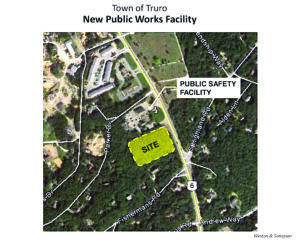TRURO — The Truro Select Board voted unanimously to place a new $30-million dept. of public works facility at 340 Route 6, a wooded area next to the police and fire depts., during a June 27 meeting.

Though the Route 6 site is town-owned, it was initially designated only for public safety, police, and fire dept. uses, DPW Director Jarrod Cabral said at the meeting. A two-thirds vote at town meeting would be needed to approve the site for public works use, he said.
Now that the site has been selected, Cabral said, the next steps will be to convene an ad hoc building committee and determine funding for the project.
The town has been interested in relocating the DPW since 2013, according to select board chair Kristen Reed, when it was included among town goals and objectives for that year. The town hired engineering consulting firm Weston & Sampson to conduct an initial feasibility study for the project, which was completed in 2019.
That study found that the total cost for the project would have been $18.6 million if construction had started in 2021. But in a report early this year, Weston & Sampson said that construction would cost $29.6 million in 2024 because of inflation and rising costs of construction and labor.
The existing facility no longer meets the needs of a DPW whose responsibilities have “increased significantly,” according to Weston & Sampson’s 2023 report. A new facility would meet current building code standards, increase productivity, and boost employee safety and morale, the report said.
Building a facility with indoor space for vehicle storage is another top priority. Currently, many of the DPW vehicles are stored outside, which leads to faster deterioration and stormwater pollution, the report said.
The Route 6 site was chosen from among five options, including the 69.9-acre Walsh property behind Truro Central School, a 40-acre property at 2 Sandpit Road, and 9 Noons Drive, which the town is looking into purchasing.
Cabral also presented two options to keep the DPW facility on Town Hall Road, both of which would involve moving a well either fully onto Snow’s Field or overlapping the field and a property owned by the Truro Conservation Trust.
Each of the five options have site-specific construction costs, which Cabral outlined for the select board during the meeting. Keeping the DPW facility at Town Hall Road and relocating the well to Snow’s Field was by far the most expensive at $4.3 million, including nearly $1 million for Snow’s Field modifications related to the well. Cabral said the town would pay about $2.9 million in site-specific costs for the Route 6 site, $2.5 million for the Walsh property, $3.2 million for the Sandpit Road site, and $2.7 million for the DPW location with an alternative site for the well.
Cabral recommended putting the facility at 340 Route 6, which he said came with advantages including an existing water main and septic system. He said co-locating the DPW facility with the police and fire depts. could make repairing, refueling, and washing vehicles from all three departments quicker and easier.
Police officers and firefighters are “here a lot,” Cabral said, referring to the existing DPW facility. “This could be a little bit more efficient operation between the three departments,” he said.
He also said having the three departments centralized would improve disaster preparedness and allow for a coordinated response.
The proposal to use the Route 6 site has drawn objections from abutters, some of whom spoke at the June 27 meeting. Ed Kinsella, who lives on Fisherman Road, said in the meeting he felt the select board does not have the “complete information and expertise it needs to make the right decision.” He said there should be environmental and traffic studies conducted before the town moves ahead.
David Reid, an attorney for the 75-member Cranberry Hill Homeowner’s Association, said the location will have a “significant detrimental effect upon the adjoining residential neighborhood” and warned board members they have “got a problem with this site that you’re going to have to deal with.” He said when the town approved a permit for the public safety building in 1992, the site was “dedicated for that singular use.”
The president of the Cranberry Hill Association, Laurie Lee, last year presented a petition with 200 signatures to the select board claiming that, when the public safety facility was approved in 1992, a building committee document said the area next to the building — where the proposed DPW building would go — must remain a “wooded buffer.” But Town Planner Barbara Carboni said last year that the zoning board of appeals made no legal requirement or condition that the area remain a buffer when it approved the 1992 permit.
During the June 27 meeting, select board member Bob Weinstein called on residents to not take legal action against the project and avoid repeating what he called the “Cloverleaf fiasco.” In early 2021, a group of Truro residents — also represented by Reid — appealed the town’s approval of an affordable housing development at the so-called Cloverleaf in North Truro. The suit delayed the project for over a year and, according to Weinstein, significantly increased its costs.
“As taxpayers, I think people should pay attention to the fact that if they’re going to object and sue the community for making a decision about the site, it will have a negative impact on their pocketbook, reflected in increased costs to the town,” Weinstein said.



